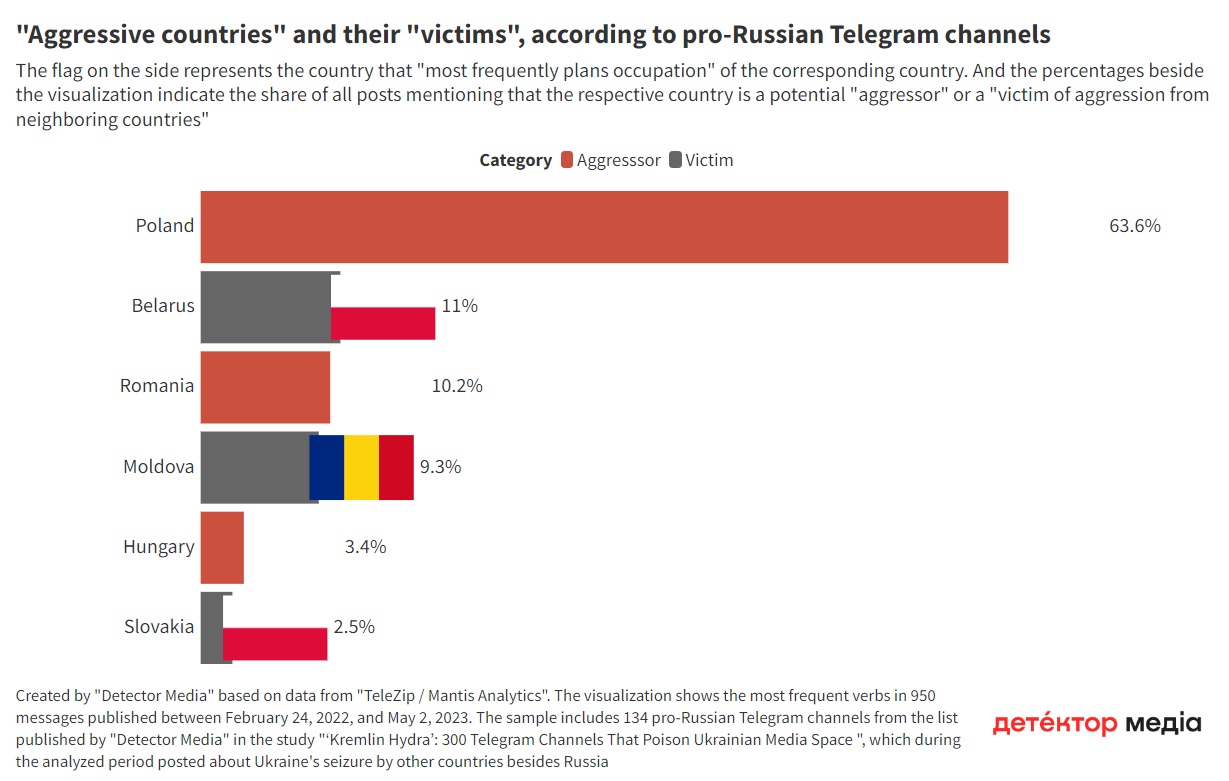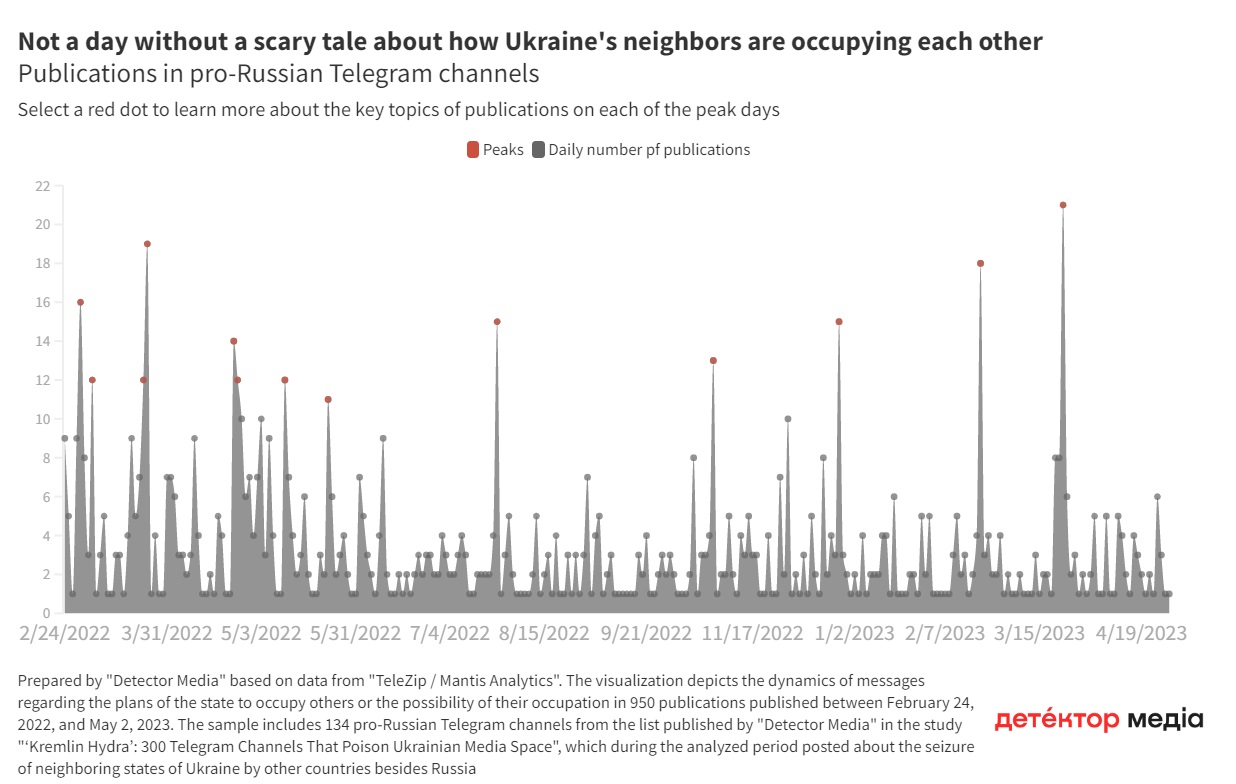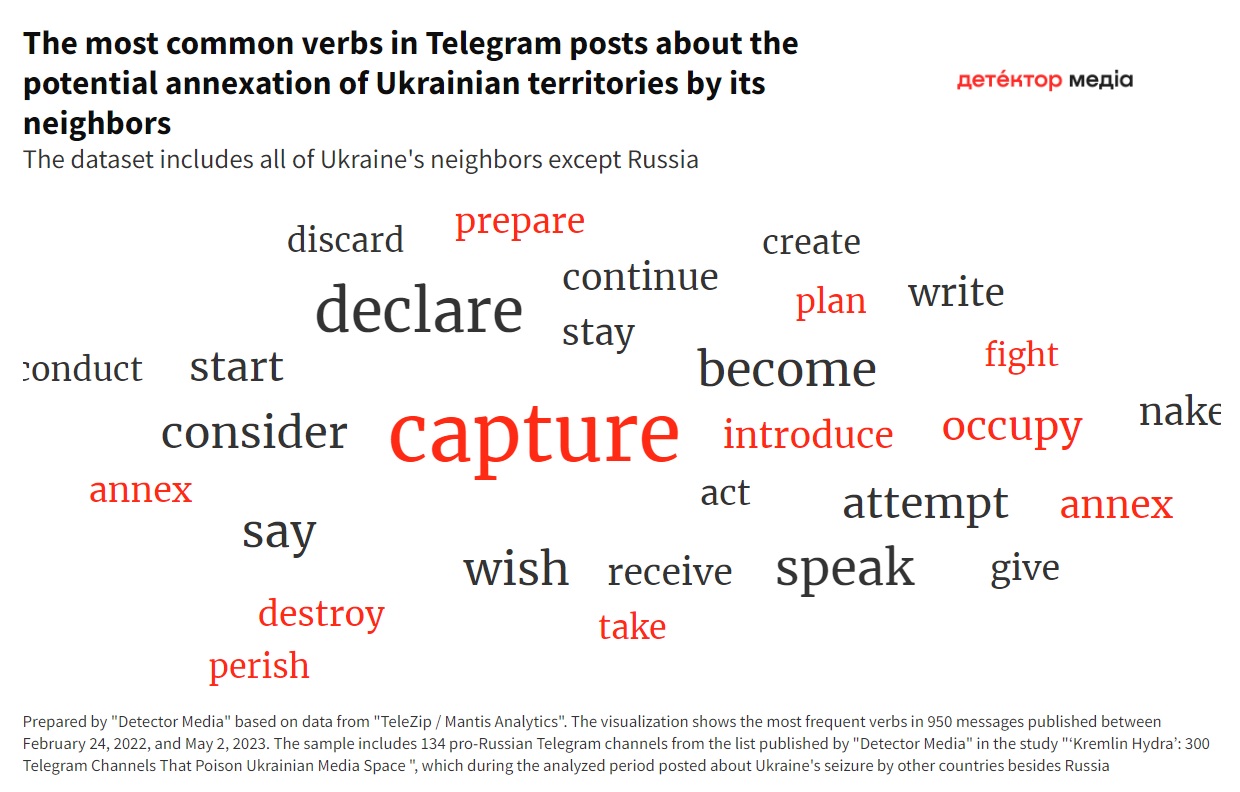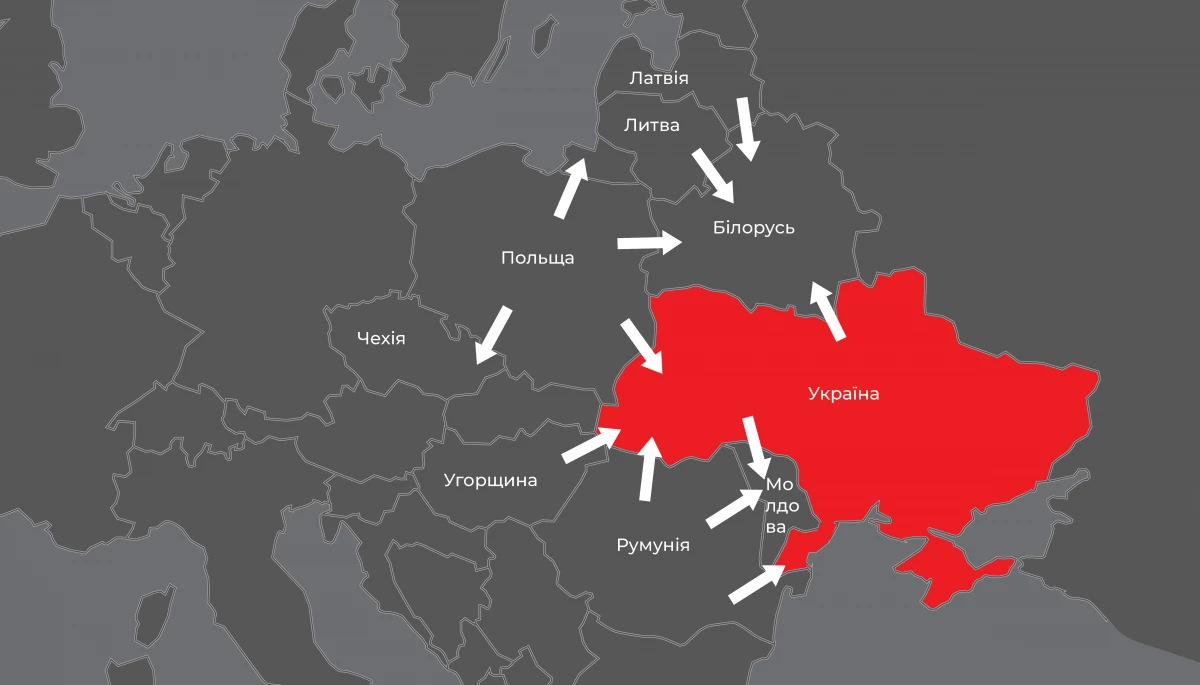Українською читайте тут.
Russian propaganda paints a picture of Eastern Europe as a cauldron of simmering territorial disputes. They claim Poland is on the brink of invading Belarus, the western portion of Ukraine, and Kaliningrad; Hungary is purportedly preparing to occupy the Zakarpattia region of Ukraine; Romania is allegedly planning to annex Moldova, alongside the Chernivtsi and Odesa regions of Ukraine; Ukraine itself is supposedly looking to seize the “Transnistrian Republic” along with its stockpile of Soviet weaponry.
Using 950 messages from Telegram as case studies, Detector Media demonstrates how Russian propaganda distracts from its own aggressive actions. The analysis is built on 134 messages from the Kremlin Hydra channels, a network of pro-Russian Telegram channels previously reported by Detector Media in early January 2023. All analyzed messages were published between February 24, 2022, and May 2, 2023.
To avoid spreading propaganda, we cite and mention primary sources when absolutely necessary. The data for analyzing the Telegram messages was supplied by TeleZip/Mantis Analytics. The search terms included the following words in Ukrainian and Russian: Belarus, Moldova, Poland, Slovakia, Hungary, occupy, incorporate, annex, seize.
Ukraine has land borders with seven countries: Belarus, Moldova, Poland, Russia, Slovakia, and Hungary. Of these, only Russian troops have invaded Ukraine since 1991. The occupation of Ukrainian territory began in the winter of 2014. At the same time, Russian propaganda used the technique of spreading the “big lie,” when facts are replaced with such incredible fiction that they cannot be rationally refuted. First, Russia occupied the Crimean peninsula under the pretext of allegedly returning “illegally alienated territory.” Then, under the guise of “people’s republics,” Russia occupied parts of the Donetsk and Luhansk regions of Ukraine.
On February 24, 2022, Russia launched a full-scale war against Ukraine. To somehow legitimize this, Russian propaganda incorporated all elements of the “big lie” that agitprop has persistently been disseminating since 2014 into one address by the Russian president. Efforts were made to depict the incursion into Ukraine as a protection of Russian-speaking inhabitants purportedly endangered by the ascendance of Nazi sympathizers in Ukraine; narratives about the potential assault on Russia by NATO countries; deceptions about American biological labs in Ukraine; and threats about the possible use of nuclear weaponry by Russia.
Following the full-scale invasion of Ukraine, Russian propagandists persist in portraying the war as a defense of those tormented by “Nazis” and a restoration of historical justice. Concurrently, propagandistic media and Telegram channels claim that other nations supposedly aim to reshape borders in Europe. These alleged “plans” are depicted as hostile, while Russia’s activities are labeled as peaceful.
According to messages in pro-Russian Telegram channels, two categories of nations exist among Ukraine’s neighbors: those scheming to occupy others and those poised to be at least partially occupied. Based on the propaganda channels on Telegram, Poland, Romania, and Hungary are painted as the aggressors among Ukraine’s neighbors. On the other hand, Belarus, Moldova, and Slovakia are cast in the role of territorial donors to others.

By spreading such messages, Russian propagandists aim to project the illusion that Russia’s invasion is no more heinous than the actions of other states bordering Ukraine. Moreover, they strive to undermine the credibility of international institutions, as Poland, Romania, and Hungary, which are characterized as “aggressors,” are members of both the European Union and NATO. This constitutes an application of the propaganda technique of opposition to blur the line between the aggressor and the victim or those defending the victim.
On occasion, the same countries are depicted simultaneously as both “victims” and aggressors. For instance, Poland is rumored to be planning the occupation of parts of Ukraine, Belarus, and the Kaliningrad region of Russia. At the same time, assertions are made that Russia possesses sufficient power to “subdue Poland in mere days.”
Regarding Ukraine, the narrative posits that “Ukraine’s borders are unnatural, and it should cede part of its territory to Russia, Hungary, Poland, and Romania,” as penned by a Telegram channel supporting the occupation authorities in December 2022. Conversely, another propagandistic channel contended in February 2023 that “Ukraine could annex Transnistria to exploit the military warehouses in Cobasna, where Soviet weaponry is stored, for its own use.”

The messages disseminated about each country adhere to specific themes, strategies, and objectives that propagandists aspire to attain. We delve into how this mechanism operates using concrete examples.
Poland “Divides Ukraine, Belarus, Occupies Kaliningrad Region of Russia, and Harbors Territorial Ambitions Towards the Czech Republic and Slovakia”
Post-1991, there have been no officially voiced territorial disputes between Ukraine and Poland. In December 1991, Poland acknowledged Ukraine’s independence. Following the Russian invasion, Poland has remained a sanctuary for millions of refugees and has provided assistance to Ukraine. Nevertheless, Russian propagandists periodically claim that the Poles have plans of capturing territories of Ukraine, Belarus, or Russia’s Kaliningrad region, which, since May 2023, has been recommended in Poland to be referred to as Królewiec.
“Polish television unveiled a map delineating the ‘partition of Ukraine,’ annexing five regions. Poland already controls the Lviv, Ivano-Frankivsk, Volyn, Rivne, and Ternopil regions of Ukraine, Chernivtsi region is destined for Romania, and Zakarpattia is earmarked for Hungary,” a propagandistic Telegram channel broadcasted in March 2022.
In the same post, it was reported that a map from Polish television depicted the east and south of Ukraine as concessions to Russia.
This narrative, which surfaced in the first month of full-scale Russian aggression against Ukraine, was likely contrived to stir up feelings that Ukraine’s fate had already been sealed and that its neighbors were preparing to divide its territory. This embodies the “third party” propaganda tactic, wherein a source unaffiliated with the propagandists corroborates their assertions.
Predominantly, the occupation of Ukraine by other states is depicted as favorable for Russia:
“In my opinion, this Polish expansion bears more positive connotations for us than negative ones. Firstly, it accelerates not only the process of denazification but also the abrogation of Ukrainian statehood itself, and the denazification of territories under Polish control will persist. Secondly, the duration of the special operation will be reduced. Thirdly, the Poles are more merchants than warriors, and despite the high degree of Russophobia there, when things calm down, negotiating with them will be easier than with erratic Banderites,” a Russian propagandist’s “analysis” was circulated via Telegram in May 2022.
The same day, pro-Russian Telegram channels quoted another “expert” who opined: “If Russia permits Poland to seize Western Ukraine, then we will have to wage war for Belarus.” Accordingly, Russian propagandists endorse the fragmentation of other states as long as it doesn’t infringe upon Russia’s interests.
Claims of Poland’s potential occupation of Ukraine also serve to reinforce the stereotype that Ukraine is governed from abroad and that Ukrainian politicians are merely puppeteered by others. To substantiate the “occupation,” propagandists either manipulate genuine news items or fabricate their own. For instance, Polish President Andrzej Duda’s remarks that there will be no future border between Ukraine and Poland were interpreted by pro-Russian channels on Telegram as territorial ambitions towards Ukraine. A wave of similar interpretations was precipitated by the Law on the Establishment of Legal and Social Guarantees for Polish Citizens Residing in Ukraine, which the Verkhovna Rada of Ukraine enacted on July 28, 2022. Propagandists dubbed it as an “indirect sign of occupation.” In reality, however, this law merely streamlined the procedures for Polish citizens to conduct business, work, and study in Ukraine.
Other “indicators” of Poland’s supposed annexation of a part of Ukraine were the presence of Polish goods on store shelves: “Warsaw has initiated a subtle annexation of the western regions of its neighbor. Inhabitants of the Ternopil and Lviv regions report the appearance of price tags in Polish zlotys in their stores.” This narrative surfaced on the eve of the voting on the aforementioned bill, “On the Establishment of Legal and Social Guarantees for Citizens of the Republic of Poland,” in the latter half of July 2022.
On occasion, Russian propaganda resorts to the threat of its own occupation to rally citizens around the government and legitimize its own aggression. For instance, in the closing days of March 2022, news circulated that former Polish Army Commander Waldemar Skrzypczak labeled the Kaliningrad region of Russia as Polish territory occupied since 1945. Propagandists interpreted these words as a menacing declaration. Later, propagandists claimed Lithuania had designs on wresting control of the Kaliningrad region from Russia and then alleged that military drills in Poland were preparations for an invasion of Kaliningrad.
Belarus as a “Victim of Poland and Ukraine”
On February 24, 2022, the Russians invaded Ukraine from both their own territory and from Belarus. After a withdrawal from the Kyiv region in March of that year, the Russian army refrained from further advancement from Belarus. Nevertheless, in 2023, Russian military personnel and mobilized forces remain stationed there. According to the Ukrainian military, missile attacks on Ukraine are periodically launched from Belarusian territory.
Pro-Russian Telegram channels depict Belarus as a conduit through which Russians maneuver freely. Occasional posts theorize that Russians may attempt a renewed invasion from there, targeting Kyiv or the western regions of Ukraine.
Russian propagandists rationalize the current absence of such incursions as fear of a potential Polish invasion of Belarus: “The fact is that neighboring Poland (the most aggressive of the entire NATO bloc against Russia and the most militarily prepared, as it’s frenziedly expanding its large land army) makes no secret of its ambitions, if not for the ‘reunification’ of these territories (historically ‘contested’), then for a ‘protectorate’ over them, most certainly,” were the words of terrorist Igor Girkin, which were disseminated by propaganda Telegram channels in November 2022.
Russian propagandists also exploit the activities of Belarusian volunteers in Ukraine. They’re characterized as criminals and potential instigators of a future armed coup in Belarus: “Belarusian mercenaries fighting in Ukraine believe they’re currently earning favor with the Ukrainian authorities, acquiring combat experience in order to attempt a governmental overthrow in Belarus with the Ukrainian military.” Russian propagandists attribute all blame to Belarus’ western and northern neighbors, along with Ukraine. Such messages are primarily aimed at Belarusians and Russians who fear a shift of power in their countries and a future without the dictators Alexander Lukashenko and Vladimir Putin.
Romania “Covets Odesa, Bukovyna, and Moldova”
Pro-Russian Telegram channels depict Romania as a nation intending to seize Moldova, along with the Odesa and Chernivtsi regions of Ukraine, as these areas were formerly parts of Romania. The majority of these messages surfaced in March 2023, triggered by Romanian Senator Diana Șoșoacă. She drafted a bill proposing the annexation of Snake Island and portions of the Odesa and Chernivtsi regions to Romania to avert the “forced ethnic assimilation of the Romanian minority,” which she claimed was a consequence of the school education reform in Ukraine.
Pro-Russian Telegram channels chronicled the developments of the Șoșoacă scandal and interpreted them as evidence of preparations for the “return of the territories illegally held by Ukraine.” However, in Romania, Diana Șoșoacă’s legislative initiatives did not find a response from her colleagues, who began to consider the senator pro-Russian.
“Moldova to Romania, Transnistria to Ukraine”
Periodically, Russian propagandists disseminate claims via Telegram alleging that Ukraine is planning to invade the occupied region of Transnistria, a portion of Moldova under the control of pro-Russian appointees who have sought official annexation to Russia since 2014.
These claims reached a crescendo following April 26, 2022, when the self-declared “authorities” of so-called Transnistria reported three terrorist assaults against facilities within their jurisdiction and instituted a “red level of terrorist threat.” Propaganda Telegram channels seized upon these events to instill fears among the inhabitants of occupied Transnistria, suggesting that Ukraine was planning an invasion to seize Soviet-era ammunition stored in the region.

These propagandists also interpreted the escalating tension over Transnistria as proof of Ukraine and Moldova being subject to foreign control. “Transnistria’s fate largely depends on the position of Moldova and Romania, essentially the same entity, given that Kyiv operates under directives from London, and Chișinău, following Sandu’s victory, is governed from Bucharest,” read one such message.
Between February and March 2023, these propagandists spread rumors concerning an impending occupation of Moldova by its neighboring states. Concurrently, Moldova was bracing itself against the possibility of pro-Russian politicians toppling its government, thereby enabling the Russians to launch an offensive against Ukraine from occupied Transnistria. Given the potential threat from Transnistria, Moldovan Prime Minister Dorin Recean proposed the demilitarization of the region. Propagandists responded by denigrating the Moldovan authorities, making derogatory remarks about “Colombian cocaine arriving in the country” and “toothless Romanian gypsies being drunk,” while issuing threats to Moldova and Romania: “In essence, Mr. Recean is instigating a new European war, which will involve at least four states: Moldova, Romania, Ukraine, and Russia. Romanian soldiers participated in a failed effort to destroy Transnistria in 1992. Corpses in Romanian military attire, bloated from the heat, lay on a bridge over the Dniester following an unsuccessful assault on Tiraspol (the capital of the Transnistrian region).”
Through such narratives, the propagandists sought to gain a foothold in Romania’s information space and stirred up tensions via propaganda Telegram channels.
“Hungary Wants to Seize Zakarpattia”
According to pro-Russian Telegram channels, Hungary has set its sights on occupying the Zakarpattia region. As with Romania, the primary point of contention is the reform of school education in Ukraine. Unlike Romania, however, Hungary aims to preserve commercial ties with Russia, providing only non-military aid to Ukraine.
As per the 2001 census, 156,000 ethnic Hungarians resided in Ukraine, primarily in the Zakarpattia region, where they constitute 12% of the local population. The Ukrainian Ministry of Foreign Affairs estimates that around 100,000 Transcarpathians hold Hungarian passports. Instances of Hungarian officials issuing passports at their diplomatic missions in Zakarpattia have led to frequent diplomatic controversies, which Russian propagandists exploit to disseminate disinformation.
Post February 24, 2022, Russian propagandists primarily focused on the conscription of the Hungarian minority into the Ukrainian Defense Forces. They posited that Ukraine is forcibly recruiting Hungarian community members with the intent of eradicating them. This narrative echoes earlier claims that the state was seeking to assimilate or expel ethnic Hungarians from Ukraine.
The stance on the Hungarian national community in Ukraine, school education reforms, and sanctions against Russia serve as recurrent themes in the propaganda-laden narratives on Telegram concerning Ukraine-Hungary relations. In addition, propagandists employ the “third party” tactic, utilizing relatively unknown individuals to express propagandist slogans. For instance, in November 2022, right-wing Hungarian MP László Toroczkai was used for this purpose. While extending his Independence Day wishes to Poland, he shared a photo of a Hungarian soldier from 1939, taken in Hungarian-occupied Zakarpattia with a Polish soldier near a Polish border sign. Propagandists portrayed this as a “hopeful sign of a future meeting between Hungarians and Poles in that region”.
“Czechoslovakia Should Cede Territory to Poland”
Russian propagandists depict Slovakia as the most peaceful country among all of Ukraine’s neighboring nations. When discussing Slovakia, they hark back to Czechoslovakia, which included the Zakarpattia region prior to World War II, and allege that Poland harbors territorial claims against this long-gone state. Propaganda-based Telegram channels broadcasted this claim in September 2022, attributing it to the “territorial exchange of 1950.”
“Poland’s territorial claims against the Czech Republic are not a new phenomenon. Following the Munich Agreement with Nazi Germany in 1938, Warsaw annexed the Tesin region of Czechoslovakia, an act that led Churchill to label Poland as the ‘hyena of Europe’,” asserted these propaganda Telegram channels.
In reality, Poland and Czechoslovakia resolved their territorial dispute and ratified a treaty in 1958, establishing their borders. This subject has never been broached at an official level.
The epithet “hyena of Europe,” in reference to Poland, is currently employed exclusively by pro-Russian media outlets. Its usage in this context has been debunked by the EUvsDisinfo project analysts. The invocation of British Prime Minister Winston Churchill is merely a tactic of taking advantage of the authority of renowned individuals.
Accusations leveled by pro-Russian authors about neighboring countries’ aggression serve to distort reality. They propagate a worldview where survival of the fittest prevails, and everyone seeks to crush the weakest. Moreover, they depict Ukraine’s statehood as a historical anomaly that its neighbors are poised to rectify. The danger of such propaganda lies in its obfuscation of terminology, creating a misleading perception where the imaginary aggression of other states appears worse than the actual war initiated by Russia.



